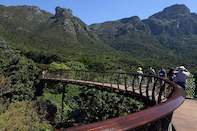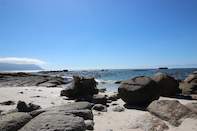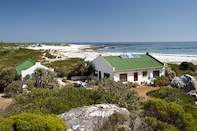Waterfront to Kirstenbosch Botanical Garden
After a scrumptious breakfast at the Waterfront, turn left onto N1 Paarl, then N2 Somerset West, M3 Muizenberg. At about 5 km keep right at Hospital Bend, following M3 Muizenberg and brown signs to Kirstenbosch. At about 10 km, turn right at traffic lights into Rhodes Drive, M63 Hout Bay and Kirstenbosch. Turn right into the gardens at 12 km.

This is the only place you'll see a baobab in the Western Cape, towering over a conservatory of desert plants and succulents, with a forest of cycads and a fern garden next door.
But the main event here in Kirstenbosch, one of the 'Seven Magnificent Botanical Gardens of the World', is the fabulous setting of manicured lawns and beautiful beds of flowers giving way to natural vegetation sweeping up to the towering mountain above.
This isn't a stuffy outing for gardeners only - it's an abundantly beautiful and peaceful place where the kids can zoom around while you enjoy breakfast in the sun. There's also a Braille Trail, a Fragrance Garden, a Useful Plants Garden, a Water-wise Garden, as well as several restaurants, a nursery and a shop.
En route on the M3 to Kirstenbosch you'll pass
Groote Schuur Hospital, on your left, where the world's first heart transplant was performed by surgeon Chris Barnard in 1967 - there is now a Transplant Museum in the theatre where the operation was performed.
Mostert's Mill, a little further on the left, is a fully restored Dutch windmill built in 1796 and a reminder that all this land was once farmland, with grain stored in the Groote Schuur (Great Barn), after which the hospital is named.
Rhodes Memorial, on your right, is a rather grand granite monument to Cecil John Rhode. On his death, he bequeathed all this land (later occupied by the University of Cape Town and Kirstenbosch) to the nation.
Kirstenbosch to Constantia Wine Route
Turn right back onto Rhodes Drive, then T-junction right to Hout Bay and Constantia Nek. At Constantia Nek circle (5 km) turn sharp left to Constantia Main Road (M41 Wynberg). The turning to Groot Constantia is at about 8 km. At about 9.5 km turn right at traffic lights into Ladies Mile Road (M39 Bergvliet). At next lights (10.5km) turn right onto M42 Tokai.
Follow the Constantia Wine Route signs to Buitenverwachting and Klein Constantia, and later Constantia Uitsig. At 15 km go straight through the circle. The entrance to Steenberg Wine and Golf Estate is at the second circle at 16 km.
Unless you're a seriously quick drinker, you'll have to pick just one or two of the estates along the Constantia Wine Route, and it's not an easy choice.
These estates were the first to produce wine in South Africa, which was enjoyed in the eighteenth century by European royals, Napoleon and even gains mention in Jane Austen's Sense and Sensibility. All estates have award-winning wines available for tasting in beautiful settings.
Constantia Wine Route to Penguins at Boulders Beach

Continue from Steenberg Estate circle and go straight through several traffic lights. At 3 km, T-junction right into Main Road M4 Muizenberg, brown sign to Cape Point. After about 600 m, turn right onto Boyes Drive for fantastic views over Zandvlei, Muizenberg and False Bay to Kalk Bay.
From Boyes Drive, look out for whales in the bay from August to October. An alternative route is to keep straight on Main Road and not turn right to Boyes Drive. Although there's usually more traffic, it takes you along the seafront through St James to Kalk Bay.
The grand stone houses that line this road make it easy to see why this used to be called 'millionaire's mile' - many were built by wealthy mining magnates who made their money from the gold and diamond rushes.
Stop at one of the popular places like the Olympia Café opposite the harbour at Kalk Bay for delectable pastries and a friendly buzz. (Turn left onto Main Road from Boyes Drive and park in the street or at the harbour.) Kalk Bay itself is also well worth a wander.
After 10 km, Boyes Drive curves left down to the T-junction with Main Road - turn right and drive through Clovelly and Fish Hoek. At 13 km turn left at the circle to Simon's Town, and travel next to the sea past Glencairn and through Simon's Town. You can either turn left at about 22 km into Seaforth Road, at the brown sign to the penguins, or go a little further and turn left into Bellevue Road, signed for penguins and Boulders Beach.
The main penguin viewing area is from Seaforth - there's a restaurant, curio stalls and a shop, with boardwalks taking you through nesting areas to a platform on the beach. But if you fancy something slightly quieter, with a chance actually to get your feet into sand and sea, go to Boulders Beach. (Entrance fee charged at both places.
There's a restaurant and gift shop before you walk down to a tiny beach that all but disappears at high tide. Here humans and penguins share the sand, and the swimming is fabulous - flat and calm, amid huge 540-million-year-old boulders. A wheelchair-friendly path behind the beach takes you all the way to the Seaforth side, so you can still see the breeding areas. Just check underneath your car before you leave - some penguins might be enjoying a bit of shade.
Penguins at Boulders Beach to Cape Point

Leave the Seaforth parking area and turn left into Main Road. After 10km turn left into Cape of Good Hope Nature Reserve. The restaurant is a further 12 km from the gate.
Here's where the continent of Africa tapers to a rugged, rocky point, and currents clash to create wild seas that lash the land, prompting explorer Bartolomeu Dias to call it Cabo Tormentoso, Cape of Storms, in 1488.
You could spend the entire day here - there are endless hikes that will reward with fantastic vistas, whales, birdlife, richly diverse fynbos and game if you're lucky. The Chacma baboons are said to be the only ones in the world to have developed a taste for seafood. Keep your distance as they can be dangerous, and definitely don't feed them. Keep car windows and doors closed if they're nearby, and back off slowly if a baboon approaches you.
You can picnic and swim at one of several beaches or tidal pools, or explore the history of the place, from San hunter gatherers who lived among these rocks, to early global explorers who landed here (Dias and Da Gama erected crosses). Stories of numerous wrecks abound, including the famous Lusitania which went down off the Point in 1911, and the Flying Dutchman, the subject of Wagner's famous opera, which sank in 1680, her captain vowing to round the Cape if it took him till Doomsday.
But this is a quick visit, so take the funicular for a brief ride up to the old lighthouse, and if you like a walk on the wild side, stroll down to the working lighthouse right at the Point, just 87 metres above the crashing surf.
 Self drive routes from Cape Town invite visitors to the Mother City to experience the natural splendour, fun activities and scenic attractio...
Self drive routes from Cape Town invite visitors to the Mother City to experience the natural splendour, fun activities and scenic attractio...